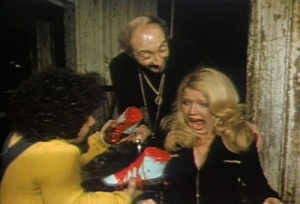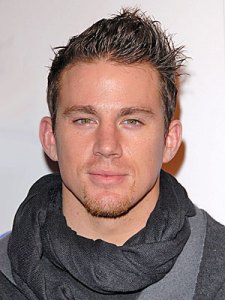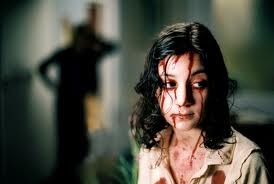It’s Christmas Eve once again and time to “wrap up” the year in entertainment.
On the Television Screen
I was relieved to see Dexter come roaring back after last year’s ridiculous storyline. I know Michael C. Hall is working for that ol’ Emmy nom but I think he’s getting serious competition from ex-wife Jennifer Carpenter, who did some really fine work with her character’s…uh…conflicted personality? Her confession of her love for her brother was just terrific, as was the choice to run and clutch LaGuerta‘s dying body after shooting her. As we head to the series’ possible final season, there’s nowhere to go but down. Debra is doomed and Dexter has lost whatever morality “the code” provided him. I just know someone is going to die. Deb wouldn’t let Dexter go to prison and I don’t think Dexter would allow himself to be caught.

Also riveting this year was The Walking Dead. Well, the season is technically not finished yet, but getting away from the farm has given the sow some welcome momentum. The creepy Governor (David Morrissey) of creepy Woodbury adds great interest, but what’s the deal with Andrea (Laurie Holden) jumping into the sack with all the messed-up bastards? First it was Shane (Jon Bernthal) and now this guy? Bad choices, lady. Apropos of nothing, I think that if someone ever does a movie about the making of Last House on the Left (which is a great idea, by the way), Bernthal should play David Hess.
Probably the most affecting scene this season occurred when young Carl (Chandler Riggs), who’s just shot his mother (Sarah Wayne Callies) after a gruesome and fatal Caesarean, carries the baby out to Rick (Andrew Lincoln) who, realizing what has happened, breaks down. I was simultaneously blubbering and marveling at the fact that a show about zombies was doing that to me.
The killing of Jimmy (Michael Pitt) in last season’s finale of Boardwalk Empire tore the heart out of that show, I’m afraid. All we have left now are heartless bastards — even Margaret (Kelly McDonald), who is destined to become an even more heartless bastard now that her side piece Mr. Sleater (Charlie Cox) is dead. And just as we were starting to grow fond of Nucky’s side piece, Billie (Meg Steedle), she explodes. At least we still have Jack Huston’s Harrow, a character who’s strange and enigmatic but not exactly heartwarming, but it’s sad that Bobby Cannavalle’s sadistic pervert, Gyp, the thorn in Nucky’s side, is already toast. Now we need to see if Nucky can regain some humanity or just continue repelling (or killing) everyone who was once close to him.

Breaking Bad is definitely heading into its last season, and it’s got the same dramatic conflicts Dexter does. Bryan Cranston’s Walter White has transformed from a cancer-stricken family man into a hardass drug lord and pretty damn ruthless killer who even terrifies his wife (Anna Gunn). It’s in those scenes with Jesse (the terrific Aaron Paul) that his humanity can still be glimpsed, and that’s what helps make the show so compelling.
The added tension includes brother-in-law Hank (Dean Norris) is starting to get hot on his trail. And he’s teamed up with Todd (Jesse Plemons), a hair-trigger douchebag who killed an innocent kid just for being there. I predict Walter will move to Central America and become the Heisenberg he always dreamed of being. Or maybe he’ll get his brains blown out.
I’m looking forward to the returns of Nurse Jackie, Shameless and The Borgias, but The Big C really need to be taken off life support. By the time the douche husband Paul (Oliver Platt) become a world-famous “blogger” and hooked up with Susan Sarandon’s ridiculous self-help guru while the son (Gabriel Basso) was doing his religious girlfriend in the back so she’d remain a “virgin,” it was just too absurd for words.
The Cinema
2012 was really a desolate wasteland for Weird Movie Village-style movies aside from the wonderful Cabin in the Woods. To be honest, I didn’t see many of the others, but hell, look at the list. A movie about demonic possession that’s only PG-13 is absurd. Plus, I couldn’t get that damn INXS song out of my head every time I saw the poster on a bus stand. And I’ve never gotten into the Underwear — er, I mean Underworld series. Worst of all, when I saw that Sinister was “from the makers of Paranormal Activity and Insidious” — any film that needs to be linked to those suckfests is required non-viewing in my book. They’re not scary and they’re actually insulting in their stupidity and pandering. If you must see a “found footage” film, see Chronicle.
Vincent D’Onofrio’s Don’t Go in the Woods turned out to be an unwatchable disappointment, and my initial interest in Abraham Lincoln: Vampire Hunter quickly cooled when I learned that screenwriter Seth Grahame-Smith was also responsible for Tim Burton’s flatulent Dark Shadows revamp. Probably the biggest genre disappointment was the computer-animated Paranorman, which started out wonderfully with bizarre character design and a bent storyline, only to devolve into a Hocus Pocus ripoff (and Hocus Pocus is more fun to watch!)
Happily, films from other genres stepped in to filled the void. Darting in and out of theaters quicker than a Manhattan bike messenger was the Joseph Gordon-Levitt starrer Premium Rush, the action film for biking devotees, which is probably a rather small focus group, but being part of that community, I loved it. Also with Gordon-Levitt was Looper, which pleased the sci-fi crowd, but the absurdity-piled-upon-absurdity climax left me cold. I still roar when I watch 21 Jump Street on cable, but the initially amusing Ted has faded into a dull memory.
 Robert Zemeckis’ Flight will certainly bring Denzel Washington another Oscar nod, and he deserves it — his portrayal of the alcoholic, unwitting “hero” pilot demonstrates true stripped-to-the-core excellence. Gus Van Sant’s Promised Land, starring and co-written by Matt Damon and John Krasinski, is getting an unfairly lukewarm reception. Sure, it wears its heart on its sleeve, but it does so in a most involving way, and Van Sant populates his film with very real characters. Matt’s pal Ben Affleck did a nice job with Argo, pulling double duty as star and director. The tense opening scene reminded me of something Costa-Gavras would do. And Alan Arkin is very funny as the world-weary producer of the fake film.
Robert Zemeckis’ Flight will certainly bring Denzel Washington another Oscar nod, and he deserves it — his portrayal of the alcoholic, unwitting “hero” pilot demonstrates true stripped-to-the-core excellence. Gus Van Sant’s Promised Land, starring and co-written by Matt Damon and John Krasinski, is getting an unfairly lukewarm reception. Sure, it wears its heart on its sleeve, but it does so in a most involving way, and Van Sant populates his film with very real characters. Matt’s pal Ben Affleck did a nice job with Argo, pulling double duty as star and director. The tense opening scene reminded me of something Costa-Gavras would do. And Alan Arkin is very funny as the world-weary producer of the fake film.
Kathryn Bigelow’s Zero Dark Thirty, torture controversy aside, is a gripping 80-minute film stretched out to almost twice that length. Of course, the critics are swooning over it, but there was never a point at which I made a visceral connection to it. Any intensity it may have had really dissipated over its bloated run time. The Hobbit, which has been slammed again and again for its length, its art direction, the HFR and crappy 3D, deserves most of the slams, but I have my reservations. Sure, Jackson is slavishly indulging his love of overblown epics, but as I recall the first LOTR in 2001 was a nightmare of boring exposition, not really clicking until we got to the second and third chapters, so who knows? I kind of enjoyed the last 40 minutes when we finally got to meet Gollum, and the climactic confrontation with the Orcs was pretty good.
 The biggest surprise of the year for me had to be Life of Pi. The name and the trailer made me think that it was going to be silly, but I was wrong. We’re talking about Ang Lee, after all. Has he ever made a wretched film? Whoops — The Hulk. Anyhow, I saw Life of Pi at the Arclight Hollywood in 3D and was completely transported by the opening credits with their bright, colorful, multidimensional close-ups of animals at probably the most beautiful zoo in the world. And whoever does opening credits these days? The 3D is used as judiciously as Scorsese’s Hugo and the digital effects are jaw-dropping.
The biggest surprise of the year for me had to be Life of Pi. The name and the trailer made me think that it was going to be silly, but I was wrong. We’re talking about Ang Lee, after all. Has he ever made a wretched film? Whoops — The Hulk. Anyhow, I saw Life of Pi at the Arclight Hollywood in 3D and was completely transported by the opening credits with their bright, colorful, multidimensional close-ups of animals at probably the most beautiful zoo in the world. And whoever does opening credits these days? The 3D is used as judiciously as Scorsese’s Hugo and the digital effects are jaw-dropping.
The Year in Music
I saw the Dandy Warhols in concert for the third time (every time at the Wiltern…hmm) and decided that I want to “Grateful Dead” them — follow them around the country and see them everywhere they play. Their newish album, “This Machine,” is great, particularly the track “Autumn Carnival.” I also saw the Grammy-nominated Fun at the Wiltern along with a thousand hysterical teenage girls. Oh, well…I must admit it was a good show and I got this really great picture of a confetti bomb going off over the audience. Their album, “Some Nights,” with the inescapable “We Are Young,” is okay, except for the songs that have too much autotune. Frontman Nate Ruess has a great voice and doesn’t need to sound like Justin Lesbeaver.
Smashing Pumpkins and Counting Crows were also a treat to see this year, with the pumpkins playing “Oceania” in its entirety and then settling down to knock out some old classics including Bowie’s “Space Oddity.” My favorite Pumpkins event of the year, though, was the release of “Mellon Collie” on vinyl for the first time in the U.S. Crows also have a decent release, “Underwater Sunshine,” which is all covers, but well-chosen, with Pure Prairie League’s “Aimee” a favorite.
 The very best concert I saw this year, though, had to be My Morning Jacket. Damn, that was a good show. They did many songs from 2008’s “Evil Urges,” which is just a terrific album. And as an added bonus, frontman Jim James’ mane of long curly hair would close over his face from time to time as he sang, giving the impression that Cousin Itt was performing. At one point, I think it was during “Touch Me I’m Going to Scream pt. 2,” I was totally mesmerized by the music. Looking around the audience, I saw that pretty much everyone was in the same blissed-out state that I was in.
The very best concert I saw this year, though, had to be My Morning Jacket. Damn, that was a good show. They did many songs from 2008’s “Evil Urges,” which is just a terrific album. And as an added bonus, frontman Jim James’ mane of long curly hair would close over his face from time to time as he sang, giving the impression that Cousin Itt was performing. At one point, I think it was during “Touch Me I’m Going to Scream pt. 2,” I was totally mesmerized by the music. Looking around the audience, I saw that pretty much everyone was in the same blissed-out state that I was in.
Next year Blur needs to regroup and come to Los Angeles. That’s an order. I bought the vinyl box set and even “Dr Dee.” That’s commitment.
 Last night was the series finale of the frustratingly bad True Blood, and — as I expected — it went out with a whimper. This show has been limping along ever since Season Three, so it really came as no surprise that it would maintain its consistent level of dullness.
Last night was the series finale of the frustratingly bad True Blood, and — as I expected — it went out with a whimper. This show has been limping along ever since Season Three, so it really came as no surprise that it would maintain its consistent level of dullness.















































